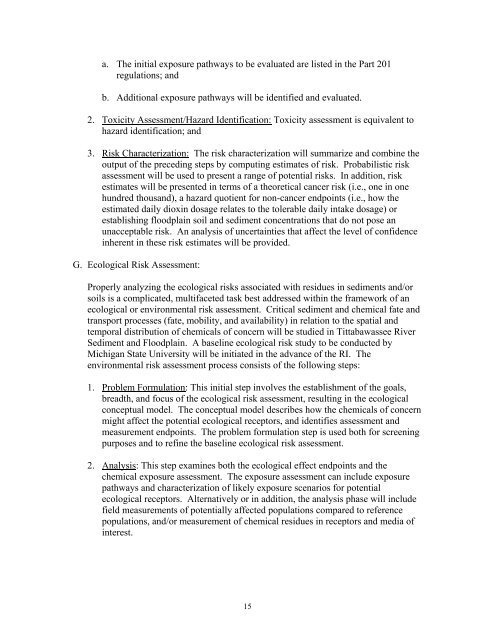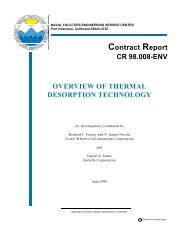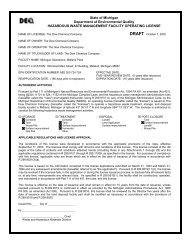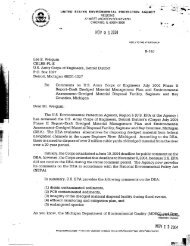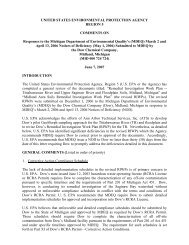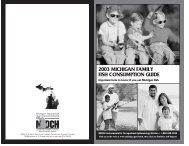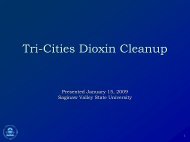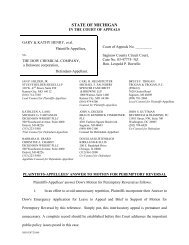Tittabawassee River and Flood Plain SOW - State of Michigan
Tittabawassee River and Flood Plain SOW - State of Michigan
Tittabawassee River and Flood Plain SOW - State of Michigan
You also want an ePaper? Increase the reach of your titles
YUMPU automatically turns print PDFs into web optimized ePapers that Google loves.
a. The initial exposure pathways to be evaluated are listed in the Part 201<br />
regulations; <strong>and</strong><br />
b. Additional exposure pathways will be identified <strong>and</strong> evaluated.<br />
2. Toxicity Assessment/Hazard Identification: Toxicity assessment is equivalent to<br />
hazard identification; <strong>and</strong><br />
3. Risk Characterization: The risk characterization will summarize <strong>and</strong> combine the<br />
output <strong>of</strong> the preceding steps by computing estimates <strong>of</strong> risk. Probabilistic risk<br />
assessment will be used to present a range <strong>of</strong> potential risks. In addition, risk<br />
estimates will be presented in terms <strong>of</strong> a theoretical cancer risk (i.e., one in one<br />
hundred thous<strong>and</strong>), a hazard quotient for non-cancer endpoints (i.e., how the<br />
estimated daily dioxin dosage relates to the tolerable daily intake dosage) or<br />
establishing floodplain soil <strong>and</strong> sediment concentrations that do not pose an<br />
unacceptable risk. An analysis <strong>of</strong> uncertainties that affect the level <strong>of</strong> confidence<br />
inherent in these risk estimates will be provided.<br />
G. Ecological Risk Assessment:<br />
Properly analyzing the ecological risks associated with residues in sediments <strong>and</strong>/or<br />
soils is a complicated, multifaceted task best addressed within the framework <strong>of</strong> an<br />
ecological or environmental risk assessment. Critical sediment <strong>and</strong> chemical fate <strong>and</strong><br />
transport processes (fate, mobility, <strong>and</strong> availability) in relation to the spatial <strong>and</strong><br />
temporal distribution <strong>of</strong> chemicals <strong>of</strong> concern will be studied in <strong>Tittabawassee</strong> <strong>River</strong><br />
Sediment <strong>and</strong> <strong>Flood</strong>plain. A baseline ecological risk study to be conducted by<br />
<strong>Michigan</strong> <strong>State</strong> University will be initiated in the advance <strong>of</strong> the RI. The<br />
environmental risk assessment process consists <strong>of</strong> the following steps:<br />
1. Problem Formulation: This initial step involves the establishment <strong>of</strong> the goals,<br />
breadth, <strong>and</strong> focus <strong>of</strong> the ecological risk assessment, resulting in the ecological<br />
conceptual model. The conceptual model describes how the chemicals <strong>of</strong> concern<br />
might affect the potential ecological receptors, <strong>and</strong> identifies assessment <strong>and</strong><br />
measurement endpoints. The problem formulation step is used both for screening<br />
purposes <strong>and</strong> to refine the baseline ecological risk assessment.<br />
2. Analysis: This step examines both the ecological effect endpoints <strong>and</strong> the<br />
chemical exposure assessment. The exposure assessment can include exposure<br />
pathways <strong>and</strong> characterization <strong>of</strong> likely exposure scenarios for potential<br />
ecological receptors. Alternatively or in addition, the analysis phase will include<br />
field measurements <strong>of</strong> potentially affected populations compared to reference<br />
populations, <strong>and</strong>/or measurement <strong>of</strong> chemical residues in receptors <strong>and</strong> media <strong>of</strong><br />
interest.<br />
15


